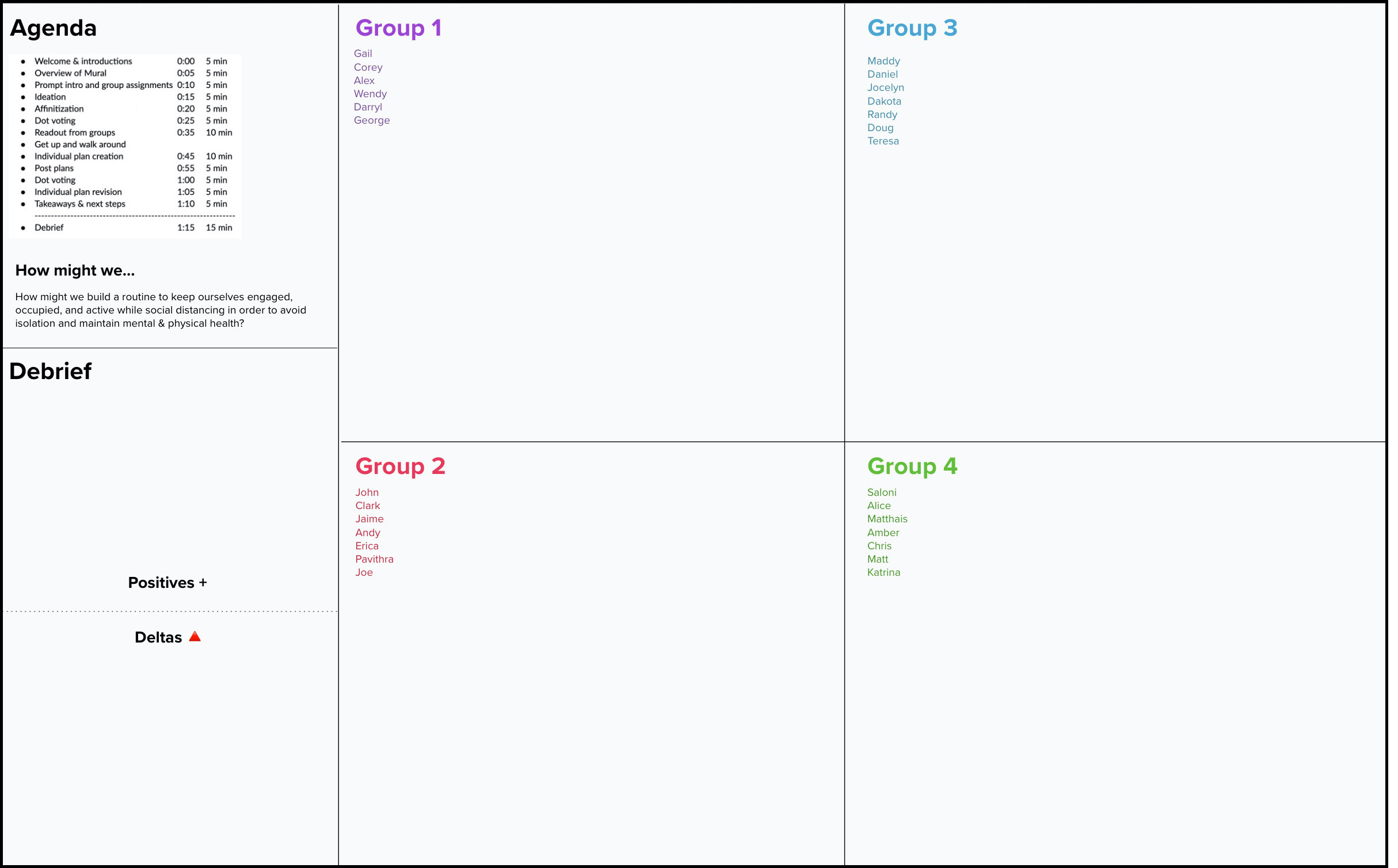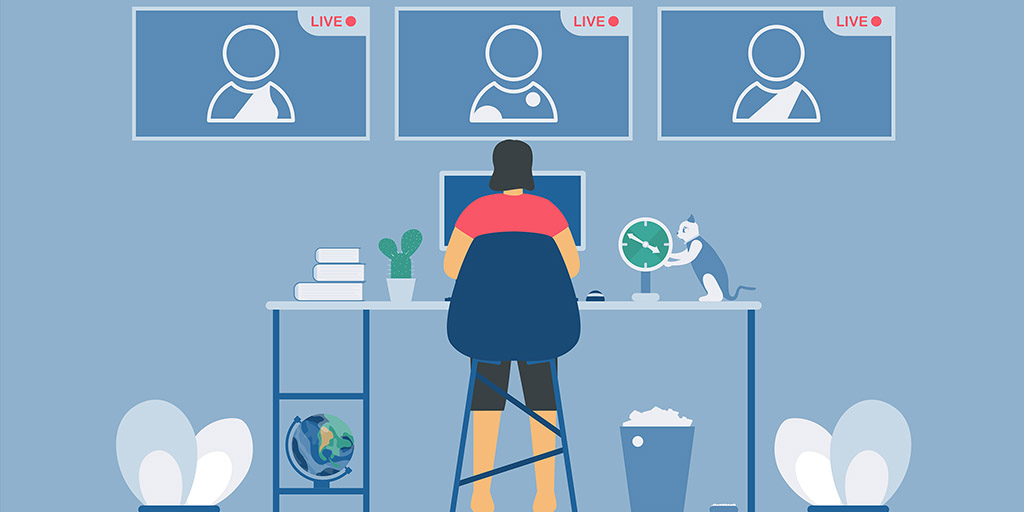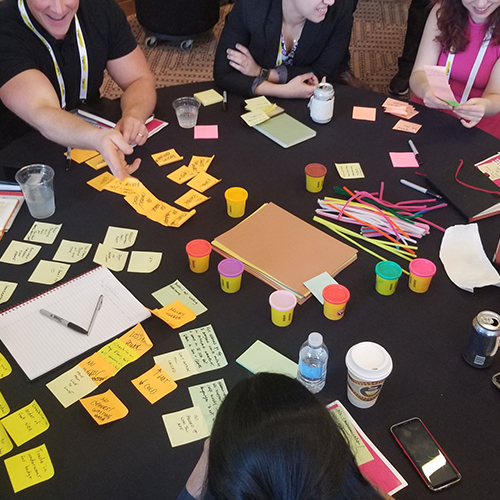I am a big believer in the value of collaborating and co-designing with my clients. For many years, I have been an outspoken proponent of design thinking workshops and how they can facilitate communication and push ideas. When well designed, workshops can expose insightful thinking, expedite process, and generate innovative ideas. Until recently, the vast majority of the workshops that I designed and supported were entirely in person.
Like so many of you, our current situation with COVID-19 has forced me to rethink the methods and processes in my design toolbox. I have been designing and facilitating workshops for over 15 years and suddenly I was feeling ill-equipped. This experience has pushed me out of my comfort zone and that has been a good thing.
There are many best practices in workshop design that apply regardless of whether you are in person or remote. For the sake of simplicity, I am going to focus only on those that apply specifically to a remote format.
Planning Remote Workshops
To better support my team and clients, I started by reading everything I could about remote workshop design. I have a background in instructional design and have previously taught online courses. This foundation helped in understanding remote learning, but workshops have specific considerations I wanted to learn more about.
Right off the bat, there were a few helpful tips that I felt were important to include in your remote workshop planning:
- Limit workshops to 60-120 minutes - It is difficult to battle fatigue and maintain engagement for more than two hours in a remote setting. After two hours, video conference fatigue sets in and you will see diminishing returns on productivity.
- Knowing the number of participants is important - It is harder to be fluid and adapt on the fly in a remote session. The number of participants can significantly impact the selection and planning of specific activities, timeboxing, and the number of facilitators needed in a remote format. You may need to finalize attendees earlier and be more strict about limiting participants for certain types of workshops or activities.
- Larger groups need multiple facilitators - Zoom breakout rooms are great and can mimic small group collaboration you would see in a large, in-person workshop. If you are working with a group of folks who are not as familiar or comfortable with workshops, you may want to include a facilitator for each breakout group in addition to a lead facilitator.
- Online collaboration spaces are key - I use Mural as an online whiteboard, but there are many options available (Miro, Stormboard, AWW, etc.). Having a space that has built-in tools for generating ideas on post-it notes, affinitizing, posting images, capturing notes, timekeeping, and dot voting will make your life so much easier.
- Use two monitors (if you can) - Use one monitor to screen share your slides or shared workspace. On the other monitor, bring up a gallery view of the participants and the chat window. This will help monitor both the activities and engagement.
- Encourage everyone to turn on their video - This seems obvious but many people will keep their video off if given the option. Seeing faces is so important for interaction and collaboration. We need to be able to build rapport and read facial expressions and body language to facilitate a workshop successfully. Take the time to ask participants to turn on their video.
Experiments & Lessons Learned
Armed with this new knowledge, my next step was to run a series of experiments. I designed and scheduled internal workshops that differed in the number of participants (6 versus 30), objectives, and activities (ideation, affinitization, dot voting, breakout sessions, sketching, etc.). The goal of these experiments was to test the tools, capabilities, timing, and limitations from a practical standpoint.
These experiments were largely successful, but there were also a few interesting surprises:
- Set up templates in advance - Mural offers pre-design templates and allows you to customize your own blank board. Take the time to set up the collaboration space to fit the goals and activities of your workshop. Write out the agenda and basic instructions. Mark out and label areas for specific activities or groups. Include names of facilitators and/or group participants if you know them ahead of time. Also remember to lock the elements of your template to prevent participants from accidentally moving them around. It is important to balance out providing guidance without adding too much polish. This is still a scrappy space and you don’t want to be too rigid or intimidate participants who are new to this.
- Reduce planned activities by 20% - Like any workshop, start by defining your goals to determine the right activities to include. Plan out the agenda and time box as you would for an in-person workshop. Then reduce the activities by 20% and add extra time into each step of your workshop.
- Remote sketching works - Sketching is a great way to make the abstract more concrete and communicate ideas. For remote workshops, this works best with smaller groups (less than 10). Prepare participants ahead of time that they will need a black marker and blank piece of paper. When sketches are complete, you can ask participants to take a picture and upload the file to your collaboration space. Another option is to have participants hold their sketch up to the camera and the facilitator can screenshot and upload the images.
- Add 2-minute stretch breaks - Video conference fatigue is real. A helpful way to battle this and break up a session is to schedule in a break. Give everyone 2 minutes to stand up, stretch, and walk away from their computer.
- Include verbal check-ins - When we are in person, it is much easier to read the room and intuit if participants are following along. In remote sessions, this is much harder. You will need to consciously pause and ask if there are any questions more often. People are more hesitant to raise their hands and ask for clarification in remote settings. This is another reason to encourage people to turn on their video.


Summary
As a final takeaway, here is a summary of my 10 tips for facilitating remote workshops:
- Limit workshops to 90-120 minutes to maximize engagement
- Confirm the number of participants early and design your activities accordingly
- Bring in additional facilitators for larger groups and/or breakout teams
- Adopt an online collaboration tool and set up your space ahead of time
- Use two monitors to observe both the participants and activities
- Encourage everyone to turn on their video, especially in smaller groups
- Reduce your planned activities by 20% compared to in-person workshops
- Try remote sketching with small groups of participants
- Add in 2-minute stretch breaks, encourage participants to walk away from their computers
- Verbally check in with participants more often and ask for verbal responses back
We have made a lot of progress and have had many successes in offering remote workshops. I encourage you to take some of the lessons I have learned, find what works for you, and expand our collective understanding of working in this format. If you are interested in learning more about remote workshops, please check out the recording of Cantina’s Coffee Chat on the topic and our remote workshop offerings.
If you enjoyed this post, please check out Part 2 where I take a deeper dive into remote workshop facilitation.
During this time of increased pressure to innovate rapidly and efficiently, let us know if you or your team need any assistance. We are happy to help! Please reach out at hello@cantina.co.



